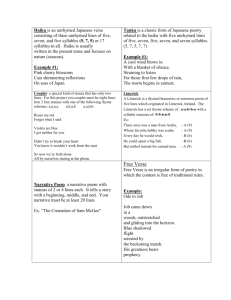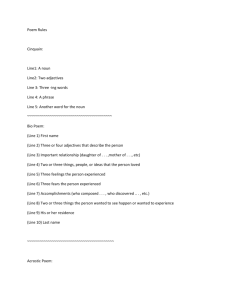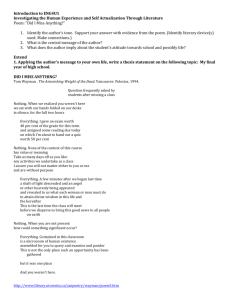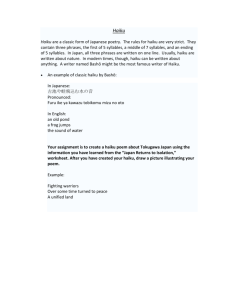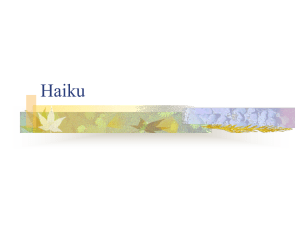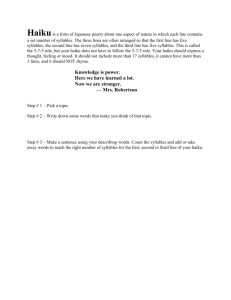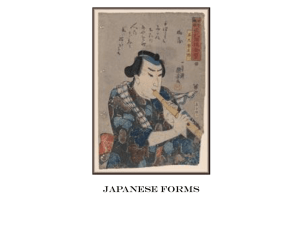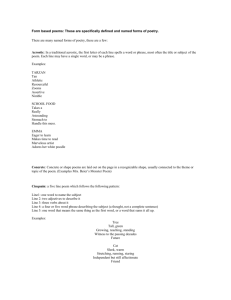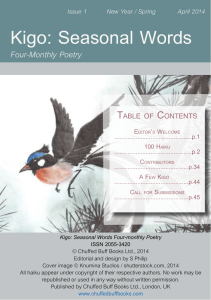Poems in seasons
advertisement
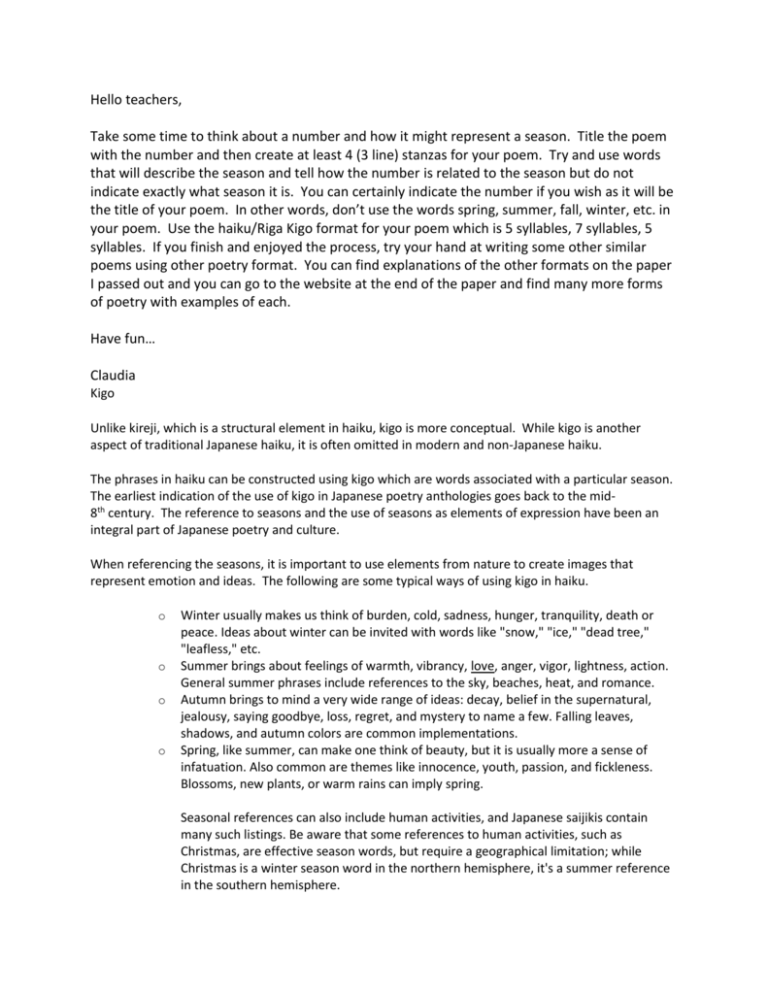
Hello teachers, Take some time to think about a number and how it might represent a season. Title the poem with the number and then create at least 4 (3 line) stanzas for your poem. Try and use words that will describe the season and tell how the number is related to the season but do not indicate exactly what season it is. You can certainly indicate the number if you wish as it will be the title of your poem. In other words, don’t use the words spring, summer, fall, winter, etc. in your poem. Use the haiku/Riga Kigo format for your poem which is 5 syllables, 7 syllables, 5 syllables. If you finish and enjoyed the process, try your hand at writing some other similar poems using other poetry format. You can find explanations of the other formats on the paper I passed out and you can go to the website at the end of the paper and find many more forms of poetry with examples of each. Have fun… Claudia Kigo Unlike kireji, which is a structural element in haiku, kigo is more conceptual. While kigo is another aspect of traditional Japanese haiku, it is often omitted in modern and non-Japanese haiku. The phrases in haiku can be constructed using kigo which are words associated with a particular season. The earliest indication of the use of kigo in Japanese poetry anthologies goes back to the mid8th century. The reference to seasons and the use of seasons as elements of expression have been an integral part of Japanese poetry and culture. When referencing the seasons, it is important to use elements from nature to create images that represent emotion and ideas. The following are some typical ways of using kigo in haiku. o o o o Winter usually makes us think of burden, cold, sadness, hunger, tranquility, death or peace. Ideas about winter can be invited with words like "snow," "ice," "dead tree," "leafless," etc. Summer brings about feelings of warmth, vibrancy, love, anger, vigor, lightness, action. General summer phrases include references to the sky, beaches, heat, and romance. Autumn brings to mind a very wide range of ideas: decay, belief in the supernatural, jealousy, saying goodbye, loss, regret, and mystery to name a few. Falling leaves, shadows, and autumn colors are common implementations. Spring, like summer, can make one think of beauty, but it is usually more a sense of infatuation. Also common are themes like innocence, youth, passion, and fickleness. Blossoms, new plants, or warm rains can imply spring. Seasonal references can also include human activities, and Japanese saijikis contain many such listings. Be aware that some references to human activities, such as Christmas, are effective season words, but require a geographical limitation; while Christmas is a winter season word in the northern hemisphere, it's a summer reference in the southern hemisphere. Add a contrast or comparison. Reading most haiku, you'll notice they either present one idea for the first two lines and then switch quickly to something else or do the same with the first line and last two. A Japanese haiku achieves this shift with what is called a "kireji" or cutting word, which cuts the poem into two parts. In English, it is essential for nearly every haiku to have this two-part juxtapositional structure. The idea is to create a leap between the two parts, and to create an intuitive realization from what has been called an "internal comparison." Two parts sometimes create a contrast, sometimes a comparison. Creating this two-part structure effectively can be the hardest part of writing a haiku, because it can be very difficult to avoid too obvious a connection between the two parts, yet also avoid too great a distance between them. Use primarily objective sensory description. Haiku are based on the five senses. They are about things you can experience, not your interpretation or analysis of those things. To do this effectively, it is good to rely on sensory description, and to use mostly objective rather than subjective words. For instance, instead of saying it's summer, focus on the warm sunlight or heavy air. Haiku Poetry Type is a Japanese poem composed of three unrhymed lines of five, seven, and five syllables. Haiku poetry originated in the sixteenth century and reflects on some aspect of nature and creates images. An ABC poem has a series of lines that create a mood, picture, or feeling. Lines are made up of words and phrases. The first word of line 1 begins with an A, the first word of line 2 begins with a B etc. An Analogy poem focuses on the likeness or similarity between things (a subject and an analog) that are otherwise unlike. Analogy is the comparison of two pairs which have the same relationship. Blank Verse is Poetry that is written in unrhymed iambic pentameter. Blank verse is often unobtrusive and the iambic pentameter form often resembles the rhythms of ordinary speech. William Shakespeare wrote most of his plays in blank verse. Lyric Poetry consists of a poem, such as a sonnet or an ode, that expresses the thoughts and feelings of the poet. The term lyric is now commonly referred to as the words to a song. Lyric poetry does not tell a story which portrays characters and actions. The lyric poet addresses the reader directly, portraying his or her own feeling, state of mind, and perceptions. A Name Poem, or Acrostic Poem, tells about the word. It uses the letters of the word for the first letter of each line. A Couplets is a Stanza of only two lines which usually rhyme. Shakespearean (also called Elizabethan and English) sonnets usually end in a couplet and are a pair of lines that are the same length and usually rhyme and form a complete thought. William Shakespeare makes use of couplets in more complex rhyme schemes Imagery Poems draw the reader into poetic experiences by touching on the images and senses which the reader already knows. The use of images in this type of poetry serves to intensify the impact of the work. Limericks are short sometimes bawdy, humorous poems of consisting of five Anapaestic lines. Lines 1, 2, and 5 of a Limerick have seven to ten syllables and rhyme with one another. Lines 3 and 4 have five to seven syllables and also rhyme with each other. Edward Lear is famous for his Book of Nonsense which included the poetry form of Limericks. Terza rima is a type of poetry consisting of 10 or 11 syllable lines arranged in three-line "tercets". The Italian poet Dante is credited with inventing terza rima and it has been used by many English poets including Geoffrey Chaucer, John Milton, Percy Bysshe Shelley and Auden. http://www.types-of-poetry.org.uk/ 1 The day is warming A Sunset on the river Birdee is joyous A flower in bloom A Conversation with friends A cool drink in hand A day of growing A day of being just me The season is here To be refreshed To see the seasonal growth Appreciating And living a day That is to be treasured By one and by all.
